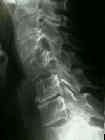- See:
- Radiographic Changes of Cervical Spine in JRA:
- Rheumatoid Arthritis:
- Transverse Ligament Rupture:
- Discussion:
- cerival spine involvement is common in RA (up to 90%) & is more common w/ long standing disease and multiple joint involvement;
- significant subluxations will occur in about 32%;
- neurologic deterioration can be irreversible, so it is essential to look for subtle signs of early neurologic involvement or myelopathy;
- most common presentations:
- atlantoaxial subluxation: (most common and may occur in up to 40%)
- atlanto-axial impaction (basilar invagniation);

- lower cervical spine:
- joints of Lushka & facet joints are affected by RA;
- pannus may trepass into the intervertebral disc, anterior longitudinal ligament, and posterior longitudinal ligament;
- subluxation may occur at multiple levels, but the middle cervical motion segments are most commonly involved.
- lower C-spine is more common in males, w/ steroid use, w/ sero-pos. RA, w/ RA nodules, & w/ severe RA;
- myelopathy:
- note that in the lower central cervical spine with less room for the cord caudally, less severe subluxation may
cause more severe myelopathic symptoms;
- lower cervical spine is the most common form of myelopathy;
- posterior fusion & wiring may be required for subluxation > 4 mm w/ intractable pain and neurologic comprimise;
- note that it is to be expected that there is also increased motion leading to subluxation adjacent to fused segments.
- Clinical Presentation:
- most common presentation is atlantoaxial subluxation C1-C2 instability w/ associated neurologic signs
& symptoms & neck pain;
- radiculopathy and myelopathic symptoms may be confused with flareup of peripheral joint disease or another neurologic disorder;
- peripheral neuropathy such as carpal tunnel syndrome is common in rheumatoid arthritis, but should not be confused with
the more generalized symptoms of C1-2 disease.
- neck pain, decrease ROM, crepitation, and occipital HA are common sx;
- neurologic impairment in pts w/ RA usually occurs very gradually and may cause decreased pain sensation and hyperreflexia early;
- Radiographic Work Up;
- Cross Table Lateral:
- MRI:
- flexion and extension MRI may be indicated to help assess cord involvement;
- MRI will also help evaluate possible encroachment of the cervical canal by synovial pannus;
- this process may be heralded by destruction of facet joints as seen on x-ray;
- Indications for Surgery:
- space available for the cord:
- spinal cord compression w/ < 14 mm of room either at upper or lower cervical spine or with basilar invagination,
is an indication for operative stabilization, regardless of patient symptoms;
- ADI:
- ADI of > 7 to 10 mm or posterior space of < 14 mm is a contraindication to elective surgery in other areas of body until the C-spine is stabilized first;
- instability is present when 3.5 mm ADI difference on flex/ext views,
- 7 mm difference may imply disruption of the alar ligaments;
- difference of > 9 mm is assoc w/ increase in neurologic injury & will usually require posterior fusion and wiring;
- myelopathy
- neurologic impairment and/or instability are indications for treatment;
- the mortality rate of untreated myelopathy is approximately 50%;
- Surgical Options:
- posterior cervical fusion;
- anterior cervical fusion;
- Complications:
- surgery is less successful in pts with servere Ranawat IIIb lesions (non ambulatory with objective weakness);
- complications include pseudoarthrosis and recurring myelopathy;
- pseudoarthrosis:
- incidence decreased by extending the fusion to occiput w/ wire fixation
References
Cervical spine fusion in rheumatoid arthritis.
Upper cervical instability in rheumatoid arthritis.
Arthrodesis of the cervical spine in rheumatoid arthritis.
Treatment of the cervical spine in rheumatoid arthritis.
Cervical myelopathy complicating multiple joint replacement in rheumatoid disease.
Surgery of the rheumatoid cervical spine. Correlation of the pathology and prognosis.
Rheumatoid arthritis of the cervical spine.
Surgical stabilization of the rheumatoid cervical spine: A review of indications and results.
Palmar shelf arthroplasty in the rheumatoid wrist. Results of long-term follow-up
Cranial subluxation of the odontoid process in rheumatoid arthritis.
Occipitocervical fusion. Indications, technique, and long-term results in thirteen patients.
Cervical myelopathy and posterior atlanto-axial subluxation in patients with rheumatoid arthritis.

